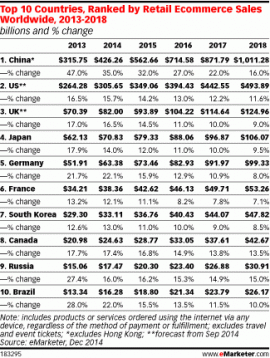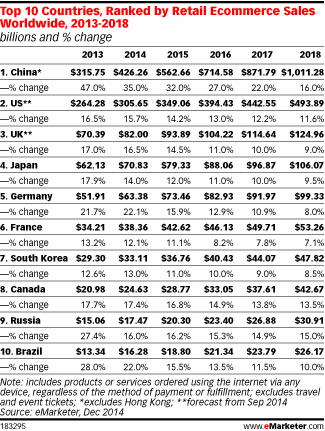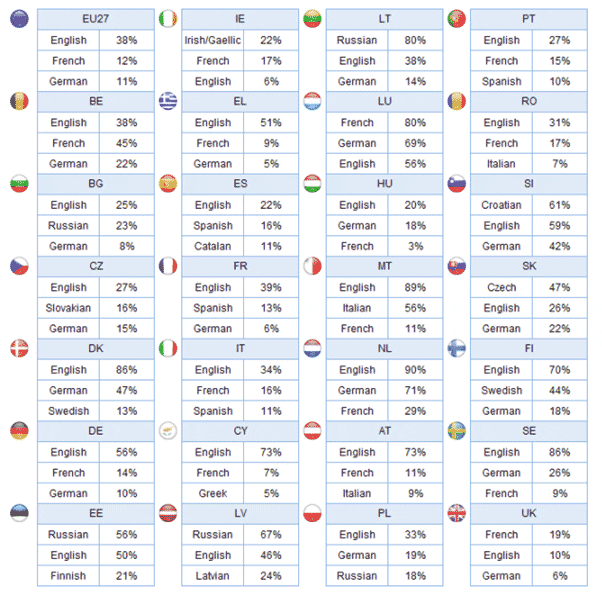International Ecommerce Strategy


Creating an International Retail Ecommerce Plan : Defining the Pros, Cons and 10 Steps to Start Planning
The UK & the US are very strong markets from an online trading point of view: the US is second in the world, and the UK third in the world in retail sales according to Emarketer. That’s a wonderful position to be in, but also means they are fairly saturated, with a high-level of competition from local and international competitors.
One of the big opportunity areas for small/medium e-commerce businesses is therefore in international sales. While international sales are vital for UK-based pureplays like ASOS, Wiggle and Zalando and many of the big online pureplays take selling overseas hugely seriously, it’s still a relatively untapped market. For example, it’s more common for continental European retailers to focus cross-border than for UK businesses to do so. And yet, the US & UK’s recognised position as ecommerce leaders put independents in a good position to explore it.

Download Expert Member resource – Running international marketing campaigns
This guide is a practical guide for how to run international marketing campaigns. It focuses on the digital elements of international marketing campaigns, and it will show how integration with offline activity should be managed.
Access the Running international marketing campaigns guide
At the basic stages of maturity of international trading, the options for a small-to-medium business selling internationally are:
A big chunk of online traders sit at #2 here: If someone from another country reaches the checkout stage, they can probably enter their address successfully, and perhaps tax has been calculated properly, but in the main it is an accident if they make international sales rather than the result of careful planning & execution.
Yet it’s easy to change that and move up the maturity scale if international retail is right for your business. This article therefore aims to help you step toward defining a loose plan to tackle international selling. It takes a look at the 3 largest benefits of doing so, plus the 3 largest negatives, before finishing with a 10 step 80/20 approach to testing the water & avoiding the big pitfalls.
As two caveats:
- Channels: there are many blog posts talking about international SEO, international CRM strategy, etc. I will try to avoid getting channel specific as I think those are topics that really deserve to be tackled in their own right.
- Resourcing: I’ll also steer clear of covering how to resource this (ie. people, agencies, etc). That varies hugely by business type so, again, would deserve covering in its own right.
The 3 Big Benefits of Selling Overseas
There are of course many benefits to selling overseas, but 3 of the biggest & most important are:
Benefit 1: True ‘Incremental’ Orders & Customers.
Whereas spending more on existing marketing channels, or adding a new channel in your main territory can sometimes result in simply spending more to reach the same customers, successfully targeting a brand new region brings 100% new customers, and orders you would not have achieved otherwise.
Benefit 2: Scalability
A big buzzword over the last few years, but internationalising allows you to scale your business, sometimes rapidly, in one of two ways:
In the main, companies tend to start with path ‘A’ to test the water, and switch to path ‘B’ in particularly promising countries based on results.
Benefit 3: Unit Economics
It’s not always the case, but often customers behave in particular patterns in different regions. For example, for a consumer ecommerce company, return rates are generally much higher in Germany than any other EU country – historically mail order companies in Germany used this as a sales tactic, and it has continued into the digital age. In Norway, the average customer is more affluent than the average customer in Greece, largely due to economic circumstances.
What this means is that the 2 key units of customer-led businesses differ greatly by region:
Of course those are not very friendly terms but, in short, by selling overseas you may be able to find pockets of higher value customers at a lower cost to your business.
Combine the 3 benefits together and, if international expansion is handled right, you stand to gain completely new, higher value customers, acquired at a lower cost, who bring the promise of further future growth.
The 3 Big Negatives of International Selling
Along with the benefits, there are of course risks & negatives:
Negative 1: (Lack of) Brand Awareness
Any ‘brand awareness’ factor you benefit from at home is likely to be very low in territories you haven’t invested in before. As a result, initially you may need to overinvest in brand to begin with, with no certainty this will pay back.
Negative 2: Distraction
It’s very easy to distract yours & your employees’ time away from your core business by chasing international sales. Everything from translation, to researching legals, to analysis, to dealing with customers, and customs, and returns takes time and effort away from the day-to-day of your native country business. As a result it’s important to be very clear about priorities, and how time and resource should be split.
Negative 3: Logistics, Legals, Language
The 3 Ls of international trading are all known quantities, but they each add a layer of complexity on top of your existing business. Working through each, making sure everything’s right, and dealing with the fallout of any issues can be tedious, particularly for smaller businesses.
10 Steps to test the water internationally
Bearing all of the above in mind, if you still have the heart & vision to move forth and test pushing sales and growing customers in other countries, here is a simple 10-step plan that may help you approach it:
Step 1: Pick your country/countries
Draw up a simple shortlist of potential countries to move into. If you have existing sales abroad, this may simply mean picking the handful of countries that have performed a little better than others & investigating them a little deeper.
Gather stats on return rates, market size for your category, shipping costs if you do not already know them.
It’s also sensible to go for the 80/20 rule based on the specifics of your business:
- If there’s a big natural market for your product in particular countries, go for those first.
- If your logistics company has strong coverage of a region, trial that.
- If your biggest supplier has a base in a particular country, see if they may be interested in a fulfilment partnership while you test the water.
- If you’re likely to have trouble with translation, pick a country where English is heavily spoken as a second language (and limit your marketing to channels used by English language speakers). For example, in the Netherlands, 90% speak English as a second language, vs just 22% in Spain:

(Source: Eurobarometer, Second Languages chart)
Step 2: Size up your competitors
Within your shortlist countries, take a look at the competitors:
- Are they ‘one stop shops’ offering everything within your category?
- How closely does their inventory overlap?
- How does their pricing match up? (and when factoring in delivery?)
- Is the paid search market competitive?
- Do you have a chance to acquire customers from them, and if so which/how?
- What are their best sellers?
As an odd tip – it’s occasionally possible to get a rough idea of their sales: Place a couple of orders on their website to understand whether their order numbers increase sequentially. If so, placing another order a month later will allow you to roughly calculate their monthly orders.
Step 3: Set up an international URL/site, and high-level marketing plan.
You may be able to get away with using a centralised site, particularly if you’re on the .com domain rather than .co.uk. In the main though, it’s useful to have regionalised presence, whether that is through setting up a www.yoursite.com/fr folder, or fr.yoursite.com, or www.yoursite.fr if it is available. Each has pros & cons, but while testing the water the important thing is to have a presence.
Alongside that, a highish level marketing plan helps you understand & prioritise the changes needed to your site.
Step 4: Fix your delivery & checkout options and messaging.
A simple step, part of a range of best practices for International Ecommerce, but also easy to miss: run through your checkout in each region making sure it all makes sense, that there are no howlers, that the language matches local expectations, and that it’s as close to native sites as is economically sensible.
Step 5: Move into multi-currency, with a payment provider that fully supports it.
Euro nation sellers have a slight advantage in that the large majority of their buyers will also use the Euro, even those technically in another country. For UK companies it is often most sensible to use a third-party provider that handles everything.
Ogone & Adyen are two of the bigger providers, and handle much of the hard compliance & localisation work. They may also assist you to understand alternate payment types by region, and turn on additionals if sensible.
Step 6: Translate the site & all messaging / marketing comms.
If you plan to go local-language, this obviously means translating. Even if you plan to simply stick with English, it’s worth going through the site ensuring you minimise colloquialisms, complex terms, and jargon that a non-native speaker would not understand.
Step 7: Sort your marketing & creative.
Next of course is marketing & creative. From your high level plan, you should drill down into each potential marketing channel looking at the minimum amount you’d need to spend to give you enough data to understand whether:
Build your target cost per newly acquired customer into this, and estimates around repeat purchase rates & return rates to help you quantify the opportunity each channel can bring, and how much you can afford to spend.
Step 8: Line up customer service & returns.
While perhaps less exciting than marketing & creative, getting these wrong can mean killing your word of mouth before you’ve gained a foothold in a country. They should be fairly easy to get right, but include decisions like: Will you take telephone support in native language, or nudge overseas buyers toward email so that Google Translate may assist? If you carry out free returns in the UK, will you extend that overseas? (and do you need to legally?)
Step 9: Make sure you’ve fully ticked off the 3 Ls
Your plan for language should already be sorted by this stage, even if that simply means you’ve drawn a rule that you’ll only use English internationally for now, or that you’ll translate into a particular high-potential language, but no other until you’ve built in scale.
Legals & logistics are very important to sort out though: What do you need to do around tax? What are the return requirements of your target countries? Do data protection/privacy laws mean you have to do anything special around capturing information? Are you covered for all eventualities from an insurance perspective?
Step 10: Plan your tests & targets
Finally, the ‘go live’ plan: Build it around a series of tests. Initially you are looking to test each market to see whether there is potential to acquire customers profitably, and to do so at a scale that makes your investment in each country enough to displace some attention away from the UK.
With that in mind your tests should answer these 3 questions:
Depending on the size of your company you may wish to build in elements to these tests to manage expectations, risks, and have an agreed fallback procedure.
Summary
Hopefully, that’s given a rough flavour of some of the issues to think through when approaching trading internationally, and also illustrated a little of the opportunity & risk of doing so. While a little wordy, the key message you may take from this is that selling & growing your business internationally need not be rocket science, or brain surgery, or grandmaster-level chess – it simply requires a solid, thought-through approach, and a well formulated foreign policy to begin testing the water.
If you have thoughts, or comments, or experience you wish to share on any of the above, do leave a comment below, or feel free to ask me any questions (@danbarker on twitter). And do share this article if you think others would find it of use.
From our sponsors: International Ecommerce Strategy



